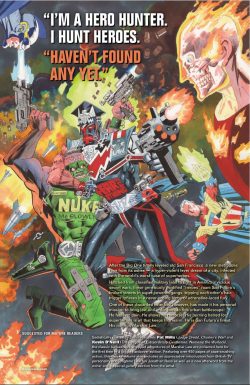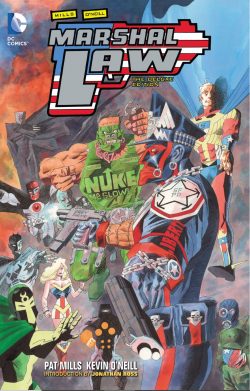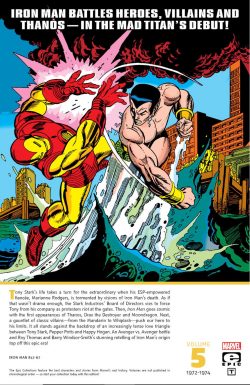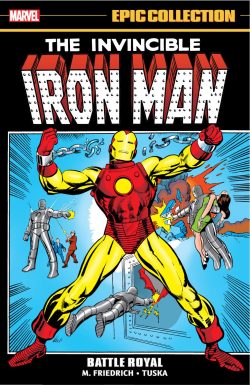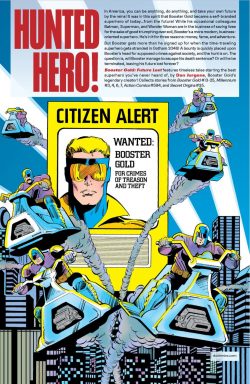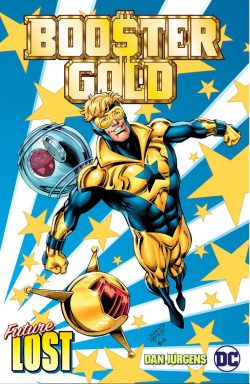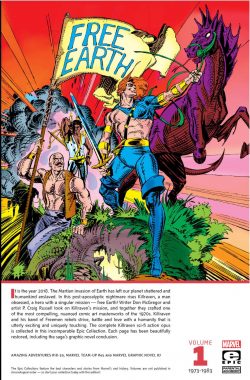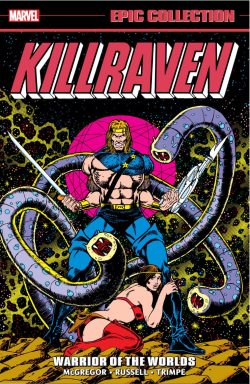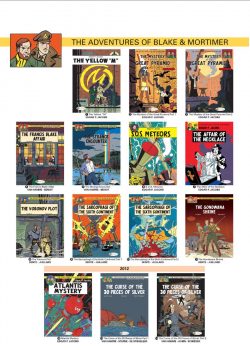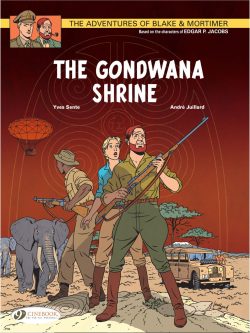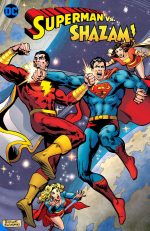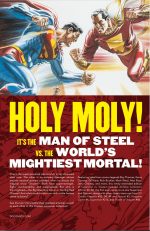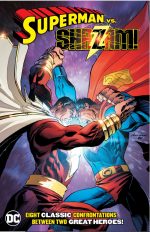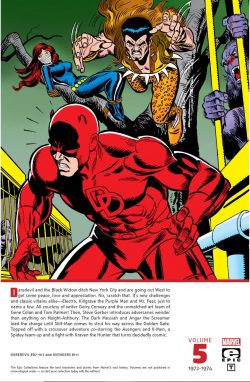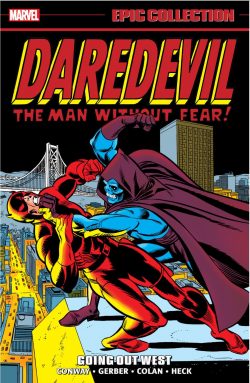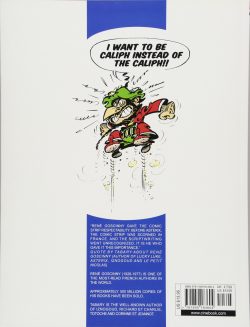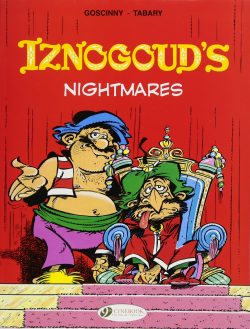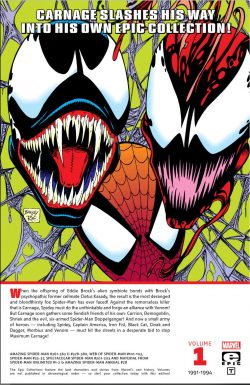
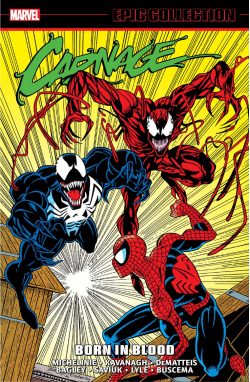
By David Michelinie, Tom DeFalco, Terry Kavanagh, J.M. DeMatteis, Mark Bagley, Ron Lim, Alex Saviuk, Tom Lyle, Sal Buscema, Steven Butler & various (MARVEL)
ISBN: 978-1-3029-4662-3 (TPB/Digital edition)
Win’s Christmas Gift Recommendation: Massive Marvel Mayhem… 7/10
After a shaky start in 1962 The Amazing Spider-Man soon became a popular sensation with kids of all ages, rivalling the creative powerhouse that was Lee & Kirby’s Fantastic Four. Soon the quirky, charming, action-packed comicbook soap-opera would become the model for an entire generation of younger heroes elbowing aside the staid, (relatively) old costumed-crimebusters of previous publications.
You all know the story: Peter Parker was a smart but alienated kid bitten by a radioactive spider during a school science trip. Discovering he had developed astonishing arachnid abilities – which he augmented with his own natural chemistry, physics and engineering genius – the kid did what any lonely, geeky nerd would do with such newfound prowess: he tried to cash in for girls, fame and money.
Making a costume to hide his identity in case he made a fool of himself, Parker became a minor media celebrity – and a criminally self-important one. To his eternal regret, when a thief fled past him one night he didn’t lift a finger to stop him, only to find when he returned home that his guardian uncle Ben Parker had been murdered.
Crazed with a need for vengeance, Peter hunted the assailant who had made his beloved Aunt May a widow and killed the only father he had ever known, finding, to his horror, that it was the self-same felon he had neglected to stop. His irresponsibility had resulted in the death of the man who raised him, and the traumatised boy swore to forevermore use his powers to help others…
Since that night the wondrous wallcrawler has tirelessly battled miscreants, monsters and madmen, with a fickle, ungrateful public usually baying for his blood even as he perpetually saves them.
In the anything-goes, desperate hurly-burly of the late 1980s and 1990s, fad-fever and spin-off madness obsessed the superhero genre in America as comics publishers hungrily exploited every trick to bolster flagging sales. In the mad melee Spider-Man spawned an intractable enemy called Venom: a disgraced and deranged reporter named Eddie Brock who bonded with Parker’s black costume (an semi-sentient alien parasite called the Symbiote) and become a savage, shape-changing dark-side version of the amazing arachnid.
Eventually the spidery adversaries reached a brooding détente and Venom became a “Lethal Protector”, dispensing a highly individualistic brand of justice everywhere but New York City.
However, the danger had not completely passed. When the Symbiote went into breeding mode it created a junior version of itself that merged with a deranged psycho-killer named Cletus Kasady (in Amazing Spider-Man #344, March 1991). The relevant pages by David Michelinie, Erik Larsen, Mark Bagley & Randy Emberlin open this collection…
Totally amoral, murderously twisted and addicted to both pain and excitement, Kasady became the terrifying metamorphic Carnage – a kill-crazy monster who carved a bloody swathe through the Big Apple before Spider-Man and Venom united to stop him.
Collecting a franchise-wide crossover which originally appeared in Amazing Spider-Man #331-363, 378-380, Web of Spider-Man #101-103 Spectacular Spider-Man #201-203, Spider-Man #35-37, and with material from Amazing Spider-Man #344-345, 359-360, Spider-Man Unlimited #1-2 and Amazing Spider-Man Annual #28 (spanning February 1991 to August 1993), this mammoth and extremely controversial summer event featured the inevitable return of the terrifying travesty and his bloodcurdling assault on everything Parker held dear: family, responsibility, love and the heartfelt faith that killing was never justifiable…
It all begins with pertinent extracts from Amazing Spider-Man #344 &345 (March & April 1991) and 359-360 (February – March 1992) as Michelinie, Chris Marrinan & Keith Williams detail Carnage’s escape and first kills before the beast’s proper debut in Amazing Spider-Man #361-363 as Michelinie, Bagley & Emberlin unleash the shapeshifting slaughterer on New York in ‘Savage Genesis!’, ‘Savage Alliance!’ and ‘Savage Grace!’, necessitating Spidey and the Human Torch breaking Venom out of his well-deserved incarceration to help stop a murder spree beyond imagining…
All that is mere aperitif to a monstrous main course of fast, furious and ferocious chaos that kicks off in‘Carnage Rising!’ by Tom DeFalco, Ron Lim & Jim Sanders III from Spider-Man Unlimited #1.
When a seemingly powerless Cletus Kasady is moved from ultra-high security penitentiary The Vault to an experimental lab at Ravencroft Asylum, ambitious psychiatrist Dr. Pournella believes she can cure the monster’s underlying psychosis. Those opinions die with her and the rest of the staff and security officers when the long-dormant Carnage entity manifests and breaks free…
Across town, tormented by guilt and shame, newlyweds Peter Parker and Mary Jane (nee Watson) are attending the funeral of their friend Harry Osborn – who had gone mad and perished battling Spider-Man as the second Green Goblin. As the downcast hero wallows in soul-searching and wonders at the point of his life, in Ravencroft a nihilistic scourge of insane bloodlust rampages through the facility until he is stopped in his tracks by another inmate.
Shriek is a creature after Carnage’s own heart: a survivor of appalling childhood abuse who found she possessed incredible powers to make all her vile drives and dreams come true…
Instantly attracted to each other, the pair join forces as a twisted “couple”, resolved to kill as often and as many as they can…
Escaping into New York they soon encounter and battle a mystical, nigh-mindless Spider-Man Doppelganger – which has been stalking the Webslinger since the end of the Infinity War crossover event – and adopt it. Together, the ultimate embodiment of a dysfunctional family set out to teach the city the pointlessness of life and the imminent inevitability of remorseless death…
Peter meanwhile has quarrelled with Mary Jane, but after making up, he hears of the bloodbath at Ravencroft and dutifully rushes off to recapture Carnage. Utterly unprepared for the trio of terror, he is savagely beaten: barely escaping with his life…
The tale continues in ‘Dark Light: Maximum Carnage Part 2’ (Web of Spider-Man #101, by Terry Kavanagh, Alex Saviuk & Don Hudson) wherein the incapacitated Arachnid is accosted by street thugs hungry for vengeance and only saved by the appearance of homeless vigilantes Cloak and Dagger.
These nomadic teens are juvenile runaways who fell into the clutches of drug-pushing gangsters. Amongst a group of abducted kids they were used as guinea pigs for new designer drugs, but though all other test subjects died horribly, Tyrone Johnson and Tandy Bowen were mutated by the chemical cocktail into something more – and less – than human.
Isolated, alone, and vengeful they swore to help other lost kids by fighting drug dealers and all who preyed on the weak in the blackest corners of New York City.
Cloak is connected to a dimension of darkness: able to teleport, become intangible, amplifying and feeding on the wickedness in his targets. His unceasing hunger for negative emotions must be regularly – if only temporarily – sated by super-acrobat Dagger’s dazzling radiance. Her power too has advantages and hazards. The light can cleanse the gnawing dependency afflicting addicts, but constantly, agonizingly, builds up within her when not released. Thus Cloak’s incessant hunger can be assuaged by her light-knives and his apparently insatiable darkness.
Whilst tending to Spider-Man – whose injuries include cripplingly painful broken ribs – Cloak & Dagger are ambushed by the Carnage clan and the consequent catastrophic clash razes the church they are sheltering in.
Shriek especially revels in chaos. She has battled Cloak before and loathes him, taking sublime joy in tormenting him. Her greatest triumph comes when she uses her sonic powers to disintegrate his beloved Dagger before his horrified eyes…
Succeeding chapters open with ‘Demons on Broadway’ (Amazing Spider-Man #378, by Michelinie, Bagley & Randy Emberlin) ramp up the tension as Venom returns to New York, determined to exterminate the appalling threat he inadvertently created. Severely wounded, Spider-Man seeks to console Cloak who is crazed with grief and fury. Elsewhere Carnage, Shriek and Doppelganger are simultaneously gloating, planning further bloodshed and fighting each other…
When Cloak disappears in a blink of black torment the barely conscious Wallcrawler resumes his search for the trio of horrors and instead stumbles upon another old foe – Demogoblin.
Originally a science-powered super-crook, the mercenary killer was cursed: mystically transformed into a supernatural scourge dedicated to cleansing Earth of sin. To his diseased mind that means slaughtering humans because they are all sinners…
As the messianic devil thrashes the utterly exhausted and overstretched Spider-Man in Central Park, Venom tracks down Kasady but is similarly crushed by Doppelganger, Shriek and his sadistically exultant “offspring”…
Brock barely escapes with his life and crawls to Peter and Mary Jane’s apartment in Spider-Man #35, driving Mrs. Parker crazy with fear and resentment. It seems as if the entire city is on the edge and ready to explode in rage, negativity and violence…
As Spider-Man resigns himself to working again with his murderous worst nightmare, Demogoblin joins Carnage’s fiendish family. The good guys recruit Peter’s ex-girlfriend The Black Cat to even the odds in ‘Team Venom’ (Michelinie, Tom Lyle & Scott Hanna), but by the time they find their constantly bickering homicidal foes, Cloak has already impetuously attacked them and lies close to death…
As another blockbusting battle ends in defeat for the heroes, the Amazing Arachnid finds himself berated and deserted by his own allies. Taken to task for his foolish unwillingness to use lethal force, Peter questions his ingrained reluctance to go ‘Over the Line!’ (Spectacular Spider-Man #201, by J.M. DeMatteis & Sal Buscema) even as Carnage adopts another psychotic menace into his growing killer kin. Cadaverous mutated clone Carrion shares their ambitions and eagerly joins in their avowed mission to kill every human in New York.
The blood-soaked brood are aided in their task by the very citizens they imperil, as an inexplicable wave of fear and hatred grips the populace, sparking savage rioting and a tide of death. The inflamed innocents even attempt to lynch Spider-Man when he comes to their aid…
As Parker faces an overwhelming crisis of conscience in ‘Sinking Fast’ (Kavanagh, Saviuk & Hudson from Web of Spider-Man #102), Venom’s vengeance squad recruits another old Spider-Man foe in the ghastly shape of Michael Morbius – a science-spawned Living Vampire with an unquenchable appetite for human blood. After years of death and torment, the helpless victim had recently begun to seek a form of redemption by only slaking his thirst on the truly wicked…
With her husband insanely risking his life beside allies as bad as the villains, Mary Jane attempts to ease her own rage by going clubbing, just as Carnage’s “carnival of chaos” tears into the fashionable nightspot eager to display their warped philosophy of senseless death.
She is only saved by the appearance of Team Venom, with Spider-Man arriving far too late to help. After helping to drive off the macabre marauders a heartbroken Parker is forced to accept the antihero’s methods: rejoining the squad in time to confront ‘The Gathering Storm’ (Amazing Spider-Man #379, Michelinie, Bagley & Emberlin).
As the notional white hats again spectacularly and pointlessly clash with the cotillion of crazies – resulting in the collateral deaths of the NYPD’s Extreme Emergency Team – a new player enters the conflict.
Deathlok was pacifist scientist Michael Collins until his consciousness was imprisoned within a cyborg body built to be the ultimate battlefield weapon. Rebelling against the corporate monsters who doomed him to “life” as a mechanical zombie, Collins turned the war body into a macabre force for justice, so when he detected strange energies at work in town he immediately entered the fray – and is trashed by Clan Carnage, just as Spider-Man and Cloak recruit idealistic mutant Firestar to their side…
Fighting chaos and terror with logic, the webspinner reasons that since all Symbiote spawn are chronically susceptible to excessive heat (as well as high energy sonic assault) a champion capable of emitting microwaves could turn the tide in humanity’s favour…
As the heroes lay their plans, ‘Hate is In The Air’ (Spider-Man #36; Kavanagh, Lyle & Hanna) exposes Kasady’s horrific childhood and events that shaped the unrepentant kill-crazed fiend. Meanwhile, martial arts hero Iron Fist steps in to rescue the broken Deathlok before the Venom gang again engages Carnage’s crew. They almost succeed, but for the rallying efforts of the increasingly rebellious and independent Shriek…
A secret is revealed in ‘The Turning Point!’ (Spectacular Spider-Man #202, DeMatteis & Buscema) as a crazed mob attacks the battling metahumans, and Shriek discloses her powers enable her to broadcast her own madness to the entire city, driving everyone into paroxysms of despair and fury. With Spider-Man actively urging Firestar to kill Carnage, the heroes’ ethical collapse seems assured…
From the depths of his soul Peter’s moral core finally breaks through the madness and he stops the equally conflicted microwave mutant from committing the ultimate sin, just as inspirational legend Captain America arrives to take charge…
With both Avengers and Fantastic Four otherwise occupied, the Sentinel of Liberty has rushed back to save ‘Sin City’ (Kavanagh, Saviuk & Hudson, Web of Spider-Man #103) from Armageddon: instantly rallying the hard-pressed heroes and their more ambivalent allies.
Sadly, his presence causes a schism and as mysterious vigilante Nightwatch joins the dark defenders in still more reactive, pointless violence, ‘Soldiers of Hope’ (Amazing Spider-Man #380, Michelinie, Bagley & Emberlin) sees Parker at last use his brains rather than brawn. With Cap’s resources, the philosophical discipline of Iron Fist and technical skills of Deathlok, a weapon is devised to disable and even cure the frenzied killers running wild in the streets…
An even greater turnabout occurs in ‘The Light!’ (DeMatteis, Lyle, Hanna & Al Milgrom; Spider-Man #37) as, at the height of the most savage battle yet, all factions are stunned by the luminescent resurrection of Dagger, who spearheads a triumphant ‘War of the Heart!’ (Spectacular Spider-Man #203, DeMatteis & Buscema) that crushes the clan and kills Carnage…
Of course it’s never that easy and the cunning maniac is only shamming, as exhausted and traumatised Spider-Man and Venom discover when the blood-red maniac ambushes them in one last all-or-nothing attack in ‘The Hatred, the Horror, & the Hero!’ by DeFalco, Bagley, Lim, Sanders III & Sam de la Rosa (Spider-Man Unlimited #2). It almost works, but in the end, battered, bruised bloodied but ultimately uncompromised, the heroes are triumphant and the horrors are caged again…
By way of epilogue Amazing Spider-Man Annual #28 (1994) picks over ‘The Mortal Past’ (Michelinie, Steven Butler & Bud LaRosa) as Kasady escapes whilst being transported to the Vault and Spider-Man goes after him. More appalling secrets of the killer’s childhood are exposed and buckets of blood are spilled as the maniac takes refuge with his only friend… until the wallcrawler spoils that too and earns Carnage’s undying hatred all over again…
Also included are an unused cover and a bound-in poster and the 1993 Carnage TPB by Bagley & Emberlin; facts, pranks and illustrations from Marvel-Year-in-Review: Bring on the Bad Guys; the Official Handbook of the Marvel Universe Master Edition; A wraparound cover by Bart Sears from Wizard Magazine, and Micheline’s Introduction from another TPB, DeMatteis’ Afterword, plus covers of successive editions by Ron Lim, Emberlin, deleted and edited scenes. There is trading card art by Steve Lightle & Paul Mounts, the cover – by Lyle – and articles from Marvel Age #123 (April 1993), a wealth or original art pages by Bagley Emberlin & Lyle and variant and 2nd print covers.
If you love the extended hyperbolic, continual conflict which is at the core of all Costumed Dramas, this non-stop battle bonanza is a grand way to spoil yourself. Logic and pacing are subsumed into one long, escalating struggle, and a working knowledge of the players is largely unnecessary to the raw, brutal clash of wills, ideologies and super-powers. One fair warning however: although handled with a degree of reserve and taste, this yarn has an appalling body count and scenes of torture that might upset younger fans of the Amazing Arachnid.
© 2022 MARVEL.

